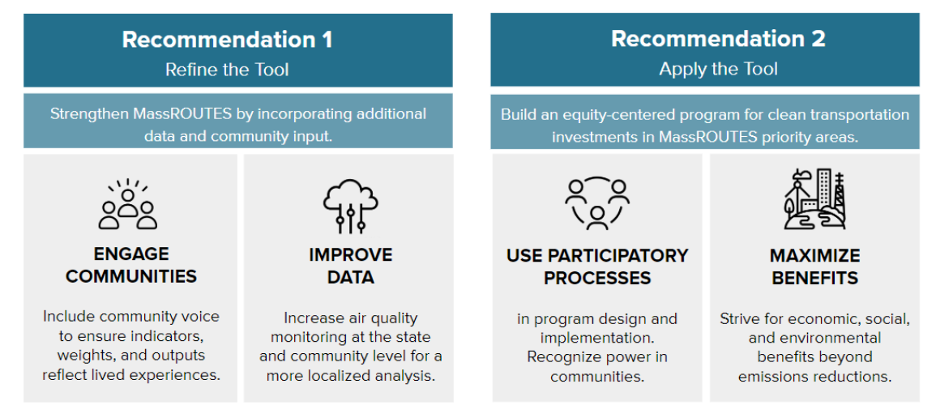The following post is adapted from a Spring 2020 UEP Field Project report, “MassROUTES: Developing a GIS-Based Screening Tool for Equity Centered Clean Transportation Investments in Massachusetts.” The report was co-written by (in alphabetical order) Rachel Bowers, Nilakshi Chatterji, Alexandra Hiple, Ellie Lochhead, and Luyi “Lucy” Xu in partnership with the Union of Concerned Scientists. Click here for more Field Projects content.
Transportation is a critical component of our everyday lives and our economy, but the transportation sector is a significant contributor to air pollution and climate change, responsible for one third of greenhouse gas emissions both nationwide and in Massachusetts (1, 2). Beyond exacerbating global climate change, transportation emissions are associated with public health concerns like asthma and other respiratory health issues.
Pollution from transportation does not impact everyone equally: in Massachusetts, communities of color are exposed to about 30 percent more fine particulate matter from transportation than white residents (3). At the same time, those who are disproportionately overburdened by poor air quality from emissions tend to also be underserved by the current system in terms of both public and private transportation methods. They are also less likely to have the resources to advocate for, or take steps to transition to, clean transportation options.
Last spring, our Field Projects team had the opportunity to work on a project in partnership with the Union of Concerned Scientists (UCS), a technical expert and policy advocacy group working to support the implementation of the Transportation Climate Initiative (TCI) in Massachusetts. TCI is a regional collaboration that aims to reduce carbon emissions from the transportation sector through a cap-and-invest program model that sets a limit on emissions and raises revenue from the sale of emission allowances under the cap (4). TCI policy is still being finalized, and one element of the advocacy work by UCS and other organizations surrounding TCI is a directive that a percentage of funds raised through the cap-and-invest program are committed to be invested directly in “priority populations.”
However, there is not yet a clear process for determining how to define a priority population or, once defined, how to make clean transportation investments in those communities in an equity-centered way. Our project aimed to identify priority populations for clean transportation investments through the development of a GIS-based screening tool and an accompanying set of policy recommendations.
The Screening Tool

The screening tool we developed is called Massachusetts Screening System to Recognize those who are Overburdened and Underserved by Transportation, Environment, and Socioeconomic status (MassROUTES). The tool can be found in interactive web map format here.
MassROUTES relies on a set of indicator variables measured at the census tract level, grouped in three main categories: Environment, Population, and Transportation. The tool uses principal component analysis to assign weights to indicators and calculates a cumulative impact score for each tract by multiplying threat of environmental exposure by socioeconomic and transportation vulnerability. By using this cumulative impacts methodology, MassROUTES reflects that exposure to transportation-related air pollution is magnified by challenges related to economic, physical, environmental, and social wellbeing (5).
The MassROUTES output highlights high-scoring priority areas as those most overburdened and underserved by the indicators in those categories, relative to all other Massachusetts tracts. Compared to other communities in the state, these priority areas would stand to benefit substantially from clean transportation investments. The final tool is a searchable, interactive web map that can be used by policymakers or advocates interested in equitable clean transportation.
The highest priority community identified by MassROUTES is in the City of Fall River. Other communities identified as high priority include locations in Boston such as Chinatown and the Andrew Square area between South Boston and Dorchester, as well as many Gateway Cities including Lawrence, Brockton, Springfield, and Worcester.
Recommendations

While MassROUTES is robust and adaptive, data-driven tools alone cannot pick up on many of the localized, lived experiences of people in the communities identified by the tool. To address this limitation, we made the following recommendations:
- Refinement of the MassROUTES tool: We recommended several steps to further improve the output of the screening tool by engaging local perspectives to review the tool and by improving air quality data collection and inclusion.
- A community-centered grant program: We also proposed the creation of a grant program that directs funds raised by TCI into priority areas identified by MassROUTES. We suggested that investments made through this proposed program follow a participatory process that results in collaborative, community-supported projects to reduce emissions while addressing other localized social, economic, and health issues.
MassROUTES offers a starting point for engaging communities, crafting planning processes, and guiding policymaking to begin addressing the inequities and challenges in our current environmental and transportation systems.
Cover image by Pixabay/Pexels
Citations
- Office of Transportation and Air Quality, “Fast Facts: US Transportation Sector Greenhouse Gas Emissions 1990-2017,” US Environmental Protection Agency, June 2019, https://nepis.epa.gov/Exe/ZyPDF.cgi?Dockey=P100WUHR.pdf.
- “GHG Emissions and Mitigation Policies,” Mass.gov, Accessed April 23, 2020, https://www.mass.gov/info-details/ghg-emissions-and-mitigation-policies.
- “Fact Sheet: Inequitable Exposure to Air Pollution from Vehicles in Massachusetts,” Union of Concerned Scientists, June, 2019, https://www.ucsusa.org/sites/default/files/attach/2019/06/Inequitable-Exposure-to-Vehicle-Pollution-MA.pdf.
- “Designing an Equitable Cap-and-Invest Policy for Transportation: An Equity Toolkit for the Transportation and Climate Initiative,” Dream Corps | Green for All, December 11, 2019, https://www.thedreamcorps.org/resource/designing-an-equitable-cap-and-invest-policy-for-transportation/.
